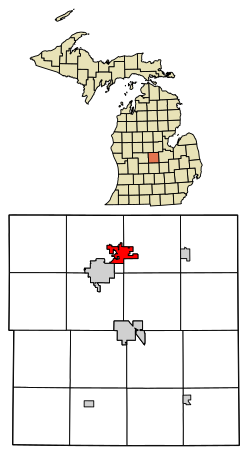St. Louis, Michigan
| St. Louis, Michigan | |
|---|---|
| City | |
| Motto: Middle of the Mitten | |
 Location of St. Louis, Michigan |
|
| Coordinates: 43°24′31″N 84°36′41″W / 43.40861°N 84.61139°WCoordinates: 43°24′31″N 84°36′41″W / 43.40861°N 84.61139°W | |
| Country | United States |
| State | Michigan |
| County | Gratiot |
| Area | |
| • Total | 3.53 sq mi (9.14 km2) |
| • Land | 3.34 sq mi (8.65 km2) |
| • Water | 0.19 sq mi (0.49 km2) |
| Elevation | 732 ft (223 m) |
| Population (2010) | |
| • Total | 7,482 |
| • Estimate (2015) | 7,255 |
| • Density | 2,238/sq mi (864.2/km2) |
| Time zone | Eastern (EST) (UTC-5) |
| • Summer (DST) | EDT (UTC-4) |
| ZIP Code | 48880 |
| Area code(s) | 989 |
| FIPS code | 26-71000 |
| GNIS feature ID | 0636831 |
| Website | www |
St. Louis is a city in Gratiot County in the U.S. state of Michigan. As of the 2010 census the population was 7,482.
According to the United States Census Bureau, the city has a total area of 3.53 square miles (9.14 km2), of which 3.34 square miles (8.65 km2) is land and 0.19 square miles (0.49 km2) is water.
It was long recognized that St. Louis sits at the geographic center of Michigan's lower peninsula "as closely as can be determined." A campaign by Clarence and Odessa Smazel in the early 1950s, owners of the St. Louis Leader-Press, a now-defunct local newspaper, resulted in the State of Michigan designating it as such: a sign in Clapp Park on Highway M-46 denotes the city as the official "Middle of the Mitten."
Indigenous people lived in this area for thousands of years before European contact. The French were early explorers in present-day Michigan. They established fur trading with the historic First Nations and Native American nations. By the 18th century, the Ojibwe were the dominant tribe in present-day Michigan. After the Seven Years' War, France was forced to cede its New France territory to the victorious English, who increased fur trade at Sault Ste. Marie. After the rebellious colonists' victory in the American Revolutionary War, the territory changed hands again, being ceded to the new United States.
It was not until the mid-19th century that much European-American settlement reached this area. In 1848 missionaries established the Bethany Lutheran Mission to serve local American Indians, mostly Anishinaabe-speaking Ojibwe (also known in the US as Chippewa). Following a Native American path to the mission, the European-American Joseph W. Clapp came to the area in 1853, where he built the first house of present-day St. Louis. Over 150 years later, the Mission still stands near Main Street Bridge across the Pine River.
...
Wikipedia
